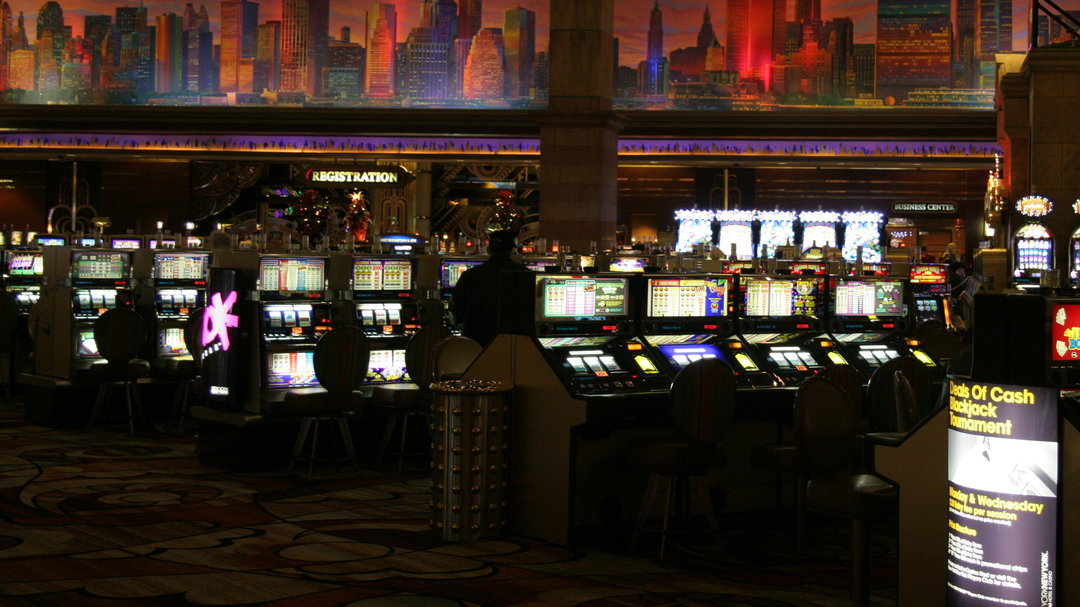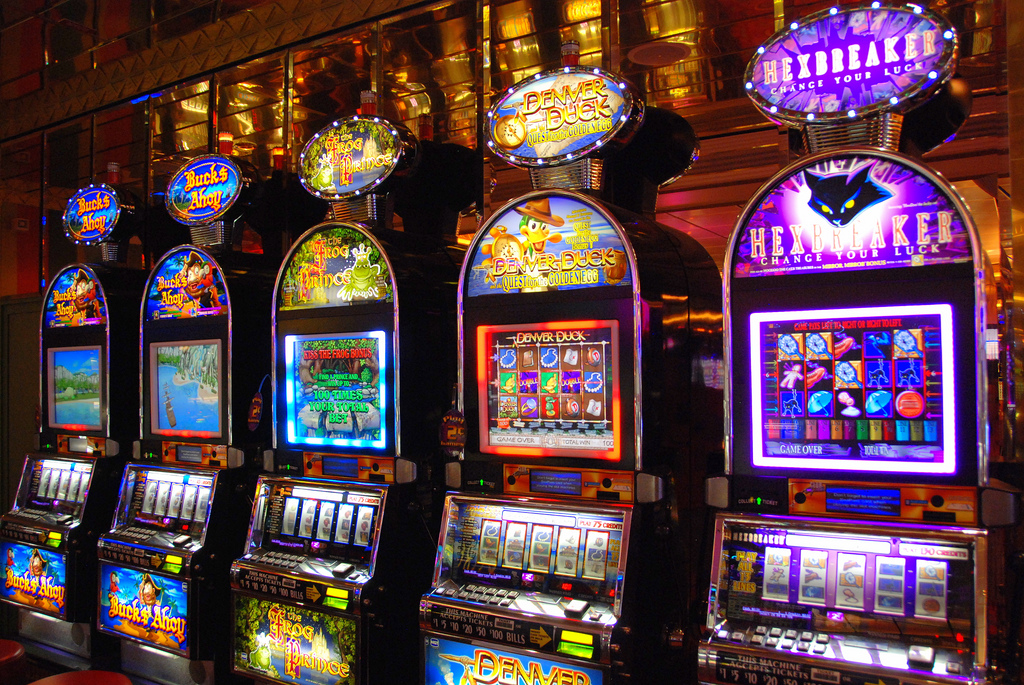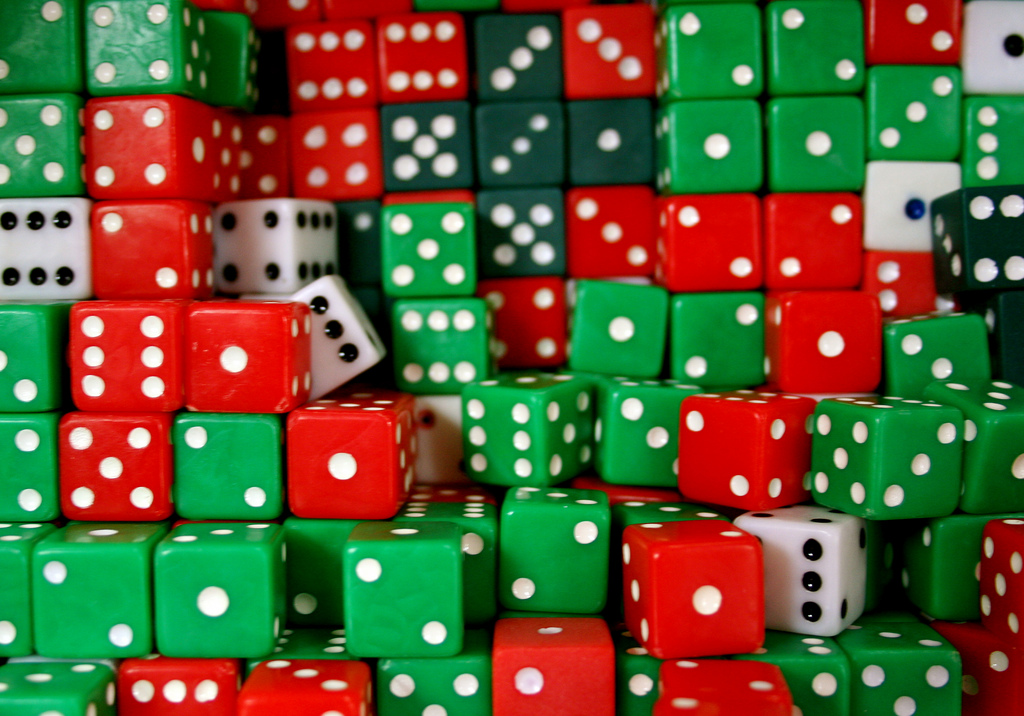
Slot-machine science
How casinos get you to spend more money
by Brad Plumer on August 7, 2014
The next time you find yourself in a casino, pause for a second to appreciate the architecture.
Casinos put an enormous amount of thought into their designs. The layout of the tables, the patterns on the carpet, the lighting — they're all explicitly engineered to make gambling more seductive and get you to spend more money.
One surprising example are the curving hallways around the property. Many casinos try to avoid making you ever have to turn at a 90° angle. As Natasha Dow Schüll explains in her fascinating book, Addiction By Design: Machine Gambling in Las Vegas, a right-angle turn forces people to call upon the decision-making parts of their brain — to stop and reflect on what they're doing. "Casinos don't want that," Schüll told me. "They want to curve you gently to where they want you to go."
Casinos put an enormous amount of thought into their designs. The layout of the tables, the patterns on the carpet, the lighting — they're all explicitly engineered to make gambling more seductive and get you to spend more money.
One surprising example are the curving hallways around the property. Many casinos try to avoid making you ever have to turn at a 90° angle. As Natasha Dow Schüll explains in her fascinating book, Addiction By Design: Machine Gambling in Las Vegas, a right-angle turn forces people to call upon the decision-making parts of their brain — to stop and reflect on what they're doing. "Casinos don't want that," Schüll told me. "They want to curve you gently to where they want you to go."
Slot machines and video gambling were once marginal to the success of casinos — but nowadays, they account for up to 85 percent of the gaming industry's profits. And casinos have devised a dizzying array of strategies to make these machines as addictive as possible, from the elaborate algorithms beneath the hood to the position of the armrests.
Schüll, a cultural anthropologist at MIT, spent 15 years in Las Vegas tracking the evolution of slot machines, exploring how and why they've become so addictive. We spoke recently by phone about how gambling has changed dramatically over time and how the gaming industry has drawn on psychological insights to make its games more addictive — often with tragic consequences.
Slot machines have become way more lucrative than traditional gambling

Slot Machines on board the Royal Caribbean cruise ship MS Independence of the Seas (Raging Wire/Flickr)
When people think of casinos, they often think of games like blackjack or roulette — high-stakes bouts of chance where fortunes can be won or lost in seconds. But that image is increasingly obsolete."Slot machines have this reputation for being these arcade devices only played by little old ladies," Schüll says. "But these devices are now driving the gambling industry and bringing in the majority of profits." By the late 1990s, slots were twice as profitable as all the other table games combined. She quotes one gambling official estimating that the machines account for as much as 85 percent of industry profits.
How did slots become so widespread? During the recession in the early 1990s, state legislatures started looking to increase revenue without raising taxes — and many of them settled on bills to allow machine gaming. "It was much easier to push through legislation [expanding the availability of slot machines] than things that carried a weightier vice image, like table gambling or poker," Schüll says.
The most recent recession saw another big bump. Maryland approved its first casino in 2008. Illinois began approving slot machines in bars in 2011. This past February, Massachusetts just approved its first slot parlor — at a racetrack outside of Boston. All told, there are now 39 states that legalize some form of electronic gambling.
But the really crucial advance was technological. In the old days, slot machines were all-or-nothing affairs: you yanked the lever and either all the cherries or the lucky 7s lined up and you won some money — or you got nothing. That sort of game was only mildly profitable, and had limited appeal to players.
By the 2000s, better computer technology changed that. "The computerization of slot machines gave casinos such precise control over odds that they could offer much higher jackpots and more exciting games while really controlling percentage payback and the odds," Schüll says. And that's when slot machines really took off.
Today's slot machines are designed to hold your attention for as long as possible
 (Paolo Pino/Flickr)
(Paolo Pino/Flickr)The gambling industry has realized that the biggest profits come from getting people to sit at slot machines and play for hours and hours on end. (Schüll says the industry refers to this as the "Costco model" of gambling.) As such, slot machines are designed to maximize "time on device."
Computerized slots have made this all possible. Again, in the old days, you pulled the lever and either won or you lost — and when people lost, they'd walk away.
Today's multi-line slot machines are far more elaborate. Instead of a single line, a player can bet on up to 100 lines at a time on the video screen — up, down, sideways, diagonal — each with a chance of winning. So a person might bet 70 cents and win on 35 of the lines, getting 35 cents back. That feels like a partial win — and captivates your attention.
That subtle advance, Schüll says, has helped revolutionize the gambling industry. Fewer and fewer people are now going to casinos to experience the thrilling chance at a big jackpot.
Instead, for many of the people Schüll interviewed, these slot machines have become a "gradual drip feed." They play because they enjoy being in the zone and losing themselves in the machine. Some players she talked to confessed that they actually get annoyed when they won a jackpot — because it disrupted the flow of playing.
The architecture of casinos helps convince people to keep gambling
But it's not just the machine algorithms themselves. Casinos have a vast array of strategies to keep people gambling.
Modern machines now have ergonomic seats that don't cut off circulation and allow you sit for hours. Buttons and bill acceptors are placed so that they can be reached with minimal arm movement (and minimal disruption to play). Casinos have discovered that the most devoted players prefer machines to be sheltered in alcoves or crannies. "The entire architecture," Schüll says, is about ensconcing you in this comfy nook that allows you to have your own private escape."
Advances in payment systems have also been crucial — players no longer have to feed coins into the machine. Bill acceptors or player cards with magnetic strips allow people to play for longer and not think about the money they're spending. Many casinos have specialized ATMs with features that allow players to get around their daily withdrawal limits by advancing money.
There are also more subtle ways to keep people at machines. If casino officials notice that a player is on a bad streak, they can come over and offer the person free breakfast (This strategy can backfire, however, since it often irritates slot players trying to lose themselves in the flow of the game.)
Alternatively, Schüll discovered, some video machines actually make internal adjustments if they notice that a player is on a losing streak and is reaching their "pain point." This has to be done carefully — it's illegal for casinos to change the odds in a game once a player has started playing.
But, she says, casinos can reduce the volatility of a game in a way that still preserves the overall payback percentage. That's technically still legal.
There's a fierce debate about who's responsible for gambling addiction

It's hard to talk about gambling without talking about addiction, and Schüll devotes a large section of her book on the topic.
There's the woman who shows up at 3 am to play slots with her four kids in tow. There's a newcomer who sits down at a slot machine in a supermarket on Tuesday and doesn't leave until Thursday — maxing out three credit cards all the while.
(Those examples aren't random: Schüll finds that the stereotypical gambler in Las Vegas is no longer an older man betting on cards or the horsetrack but a 35-year-old mother of two hooked on slots.)
The gaming industry tends to argue that it's only 1 to 2 percent of the population that has a severe addiction problem. Everyone else can largely play without adverse consequences. (Studies have found that these problem gamblers also contribute between 20 to 60 percent of total gambling revenues.)
But Schüll thinks the situation is more complicated than that. She cites studies by Brown University psychiatrist Robert Breen, who finds that video gambling machines are three to four times more addictive than games of old. "Of course some people are more predisposed to these kinds of problems by virtue of biography or brain chemistry," Schüll tells me. "But by the same token, certain technologies are more liable to addict. And I think its important to look at the technology."
"These games are solitary, they're really fast, they're continuous and uninterrupted," she says. "You're playing up to 1,200 spins an hour. And every event is another opportunity to reinforce behavior." So it's hardly a surprise that people quickly become addicted — losing themselves in the machines for days on end.
Schüll isn't convinced by industry arguments that responsibility for problem gambling belongs solely on individuals. "The whole modus operandi of the industry is to approach the human being as something that's manipulable. So I find it disingenuous that they then turn around and argue that 100 percent of the responsibility for any harm is on the person."
Some countries are mulling stricter regulations for machine gambling

In her book, Schüll argues that it's worth considering stricter regulations on video gambling — not a ban, but a way to mitigate the worst addictive effects. "It seems absurd to me that the FDA regulates aspirin but no one regulates these machines," she told me.
Still, regulating these machines is easier said than done. Countries like Canada or Australia have experimented with small tweaks, like requiring pop-up messages that alert the player if they've been playing for too long. But researchers have found that other proposed interventions — like slowing down the reels — may actually backfire by lengthening the amount of time people play.
In the United States, meanwhile, Schüll argues that regulations remain lenient. States that are trying to expand video gambling as a source of revenue have been reluctant to throttle the nascent industry. That's particularly true now that casinos sales are falling and many states aren't getting the revenue they hoped.
Schüll does point to Massachusetts, however, as an example of "forward-looking" regulation, with policies that give frequent gamblers incentives to join "pre-commitment" programs — where they can limit in advance how much money they want to spend, before they start playing.
But for the most part, the conversation around the addictive aspects of these machines is still fairly young. "I see my work as trying to open the door to discussion of this technology," she says, "and to figure out whether some sort of accountability and regulation of it might be appropriate."
http://www.vox.com/2014/8/7/5976927/slot-machines-casinos-addiction-by-design




No comments:
Post a Comment